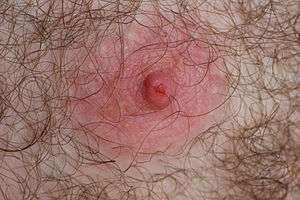Fissure of the nipple
| Fissure of the nipple | |
|---|---|
 | |
| An irritated nipple, or jogger's nipple, acquired while riding a bike on a warm day. | |
| Classification and external resources | |
| ICD-10 | N64.0, O92.1 |
| ICD-9-CM | 611.2 |
Fissure of the nipple, also known as jogger's nipple, is a condition that can be caused by friction that can result in soreness, dryness or irritation to, or bleeding of, one or both nipples during or following running or other physical exercise. This condition is also experienced by women who breastfeed[1] and by surfers[2] who do not wear rash guards.
Cause
Jogger's nipple is caused by friction from the repeated rubbing of a t-shirt or other upper body clothing against the nipples during a prolonged period of exercise.
The condition is suffered mainly by runners. Long-distance runners are especially prone, because they are exposed to the friction on the nipple for the greatest period of time. However, it is not only suffered by athletes; the inside of a badge, a logo on normal items of clothing, or breastfeeding[1] can also cause the friction which results in this condition.
Prevention
The condition is easily preventable and treatable. Viable methods include:
- Avoiding the use of large, loose-fitting T-shirt during exercise.
- Wearing shirts made of synthetic fabrics instead of cotton.
- Applying a waterproof adhesive bandage, or surgical tape over each nipple before exercise to act as a barrier between skin and cloth.
- Applying an anti-chafing balm or petroleum jelly prior to exercise.
- Using specialized products available to prevent the condition such as rash guards or nipple guards.
- Wearing a sports bra, shimmel, compression vest, or some variety of chest binding clothing.
- Avoiding wearing a shirt or other upper body covering.
Treatment
Various methods for treatment include:
- Applying an antiseptic cream as soon as a fissure is suspected, to reduce the chances of bacterial infection that would make the condition worse.[1]
- If the skin is already damaged, applying petroleum jelly can prevent healing if used over a period of time.
- A "liquid bandage" can be helpful for healing or prevention, although it may sting initially.
- Use of a nipple shield (of rubber, silver or glass and rubber) temporarily.[1] [3]
This condition should clear within a few days. If not, medical attention is warranted. Other skin conditions such as eczema, psoriasis, impetigo, fungal infections or an allergic reaction can cause nipple pain and changes in the appearance of the skin. In women, breastfeeding (often complicated by thrush infection),[1] hormonal changes in early pregnancy or during menstruation, as well as certain types of breast cancer, i.e. Paget's disease of the breast, can also cause nipple soreness and pain.
Other names
Jogger's nipple is also known as runner's nipple, red eleven, raver's nipple, big Q's, red nipple, stingers, weightlifter's nipple and gardener's nipple, athlete's nipple, or nipple chafe. There are similar colloquial terms for almost any activity that can result in the condition.
See also
- Runner's knee
- Golfer's elbow
- Nintendo thumb
- Jogger's toe
- Surfer's ear
- Tennis elbow
- Tennis toe
- Turf toe
- Cello scrotum
- List of cutaneous conditions
References
- 1 2 3 4 5 Dr. C.H. Asrani. "Fissures of the nipple". Common Problems in the first weeks of Breast Feeding. GrowingWell.com. Retrieved 10 February 2011.
- ↑ Specialist Consultant Oncoplastic Breast and Cosmetic Surgeon Mr Iain Brown. "Surfer's Nipple". Causes of Nipple and Breast Pain in Surfers. SurfersNipple.com. Retrieved 4 June 2013.
- ↑ Evaluation of the Effectiveness of a Silver – Impregned Medical Cap for Topical Treatment of Nipple Fissure of Breastfeeding Mothers, Breastfeeding Medicine, Volume 10, Number 5, 2015
External links
- "Medical Tape Nipple Saver". 2009-03-05. Archived from the original on 2013-06-10. Retrieved 2014-07-20.